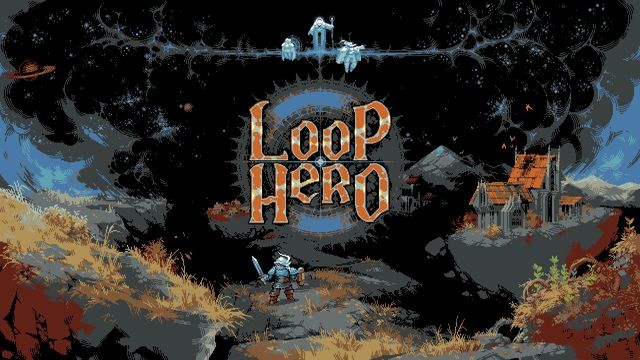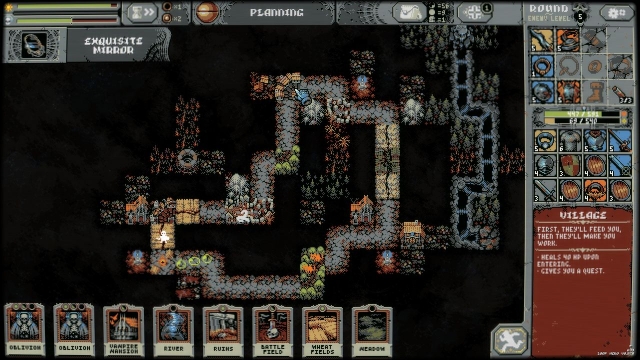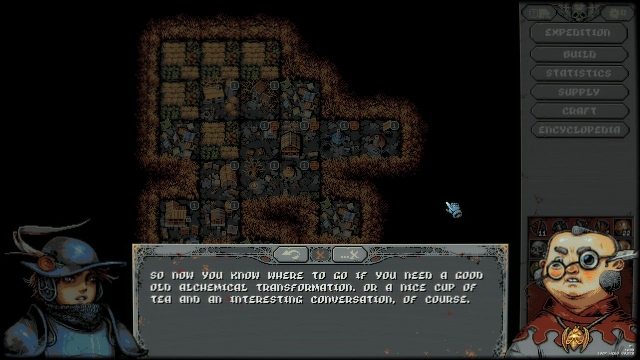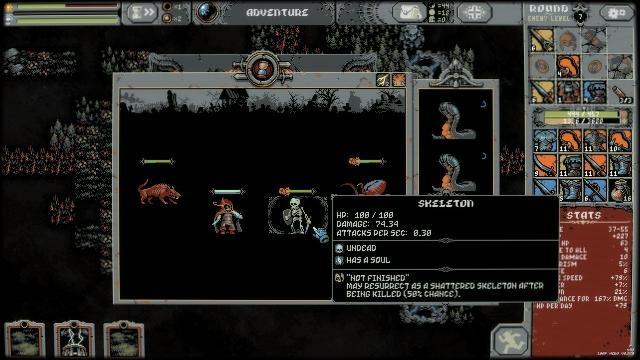Loop Hero

Loop Hero, from Russian developer Four Quarters and indie publisher Devolver Digital, is a roguelike, tile-based, strategy RPG that fuses elements of auto battlers, deck building, and base management. If it sounds like a mouthful, that’s because it is. Truth be told, I didn’t know the first thing about Loop Hero until about a month ago, when a demo dropped during the Steam Game Festival. Many who played the demo called Loop Hero one of the best-in-show, so I jumped at the opportunity to check the game out for myself and I’m glad I did. Devolver Digital has a knack for finding hidden gems and Loop Hero is no exception.
“The Lich has thrown the world into a timeless loop and plunged its inhabitants into never ending chaos.” So goes the premise of Loop Hero, as you play a brave hero tasked with defeating this devious guardian and restoring balance to the once thriving earth. To accomplish this, you’ll embark on an expedition along a randomly generated, looping path engulfed in darkness. You won’t actually control the hero; this is where the auto-battler portion of the game comes in. Instead, your job, in a sort of dungeon master role, is to play cards to place enemies, buildings and terrain around the loop for the hero to encounter, visit and benefit from as they march repeatedly around the path. These mystical cards are earned by defeating enemies in combat.
Initially the loop will be populated by a handful of slime. As you defeat these creatures you’ll be rewarded with weapons and gear to equip for combat, resources to take back to camp (more on that later), as well as the aforementioned cards. When placed directly on or adjacent to the loop, monster cards like Spider Cocoon, Grove, Cemetery and Swamp will spawn spiders, ratwolves, skeletons and mosquitos; enemies that continually spawn every day or two (a meter fills in the corner, indicating the days passing). Examples of building cards include Battle Field, which spawn a treasure chest after each successful loop; Road Lanterns, which limit the number of enemies that can occupy a single tile on the path; and Beacon, which increases movement and attack speed within its area of effect. Last but not least, terrain cards like Mountain/Rock, Thicket/Forest and Meadow grant bonuses such as additional hit points or more effective daily healing.
Each expedition quickly becomes a risk/reward scenario. You want each gauntlet to be challenging enough that the rewards are useful and plenty, but not so much that you risk surviving it at all. You see, initially the goal is to survive as many loops as possible before retreating back to your camp. Resources are the only currency you’ll get to keep after each expedition, so it’s important that you return to camp with as many resources as possible. A campfire tile represents your camp (as well as the starting point of the loop) and only when you retreat from the campfire will you be able to keep 100% of the resources you’ve earned through your journey. If you are killed in combat, for example, you’ll return to your camp with only a third of the resources you gathered (you can retreat at any point along the loop, excluding combat, with 60% of your resources). Eventually you’ll grow powerful enough to fight the story chapter’s boss (a second meter also fills in the corner, indicating when the boss will spawn), but for now let’s return to camp.
You’ll spend the resources earned from expeditions to build and upgrade structures in your camp. For instance building a Smithy let’s you start an expedition with basic warrior’s gear and unlocks the ability to craft tools; constructing the Herbalist’s Hut allows you to take up to 3 healing potions; while building a Gymnasium unlocks the ability to gain special traits after killing monsters in expeditions. Most of these structures unlock additional cards to add to your deck – including gold cards that yield powerful effects – while others unlock new character classes (there are three classes in total: Warrior, Rogue and Necromancer, each radically different in play style). Eventually you’ll gain the ability to craft supplies for the residents of your camp, which in turn provide stat bonuses and other benefits, such as increasing the chance of finding rare items on expeditions. As resources are vital in improving the hero’s chances of survival on expeditions, grinding loops and farming for resources is a reality in Loop Hero. While I thought the game’s first three chapters progressed at a good pace, I did experience a difficulty spike in the final chapter that forced me to grind a little more towards the end, though never to the point of tedium.
I hope that I’ve done a decent enough job explaining the basics of Loop Hero. It’s the kind of game that you learn on the fly as you unlock new cards, character classes and abilities. To be honest, I’ve only scratched the surface of what this game has to offer. There’s a lot of hidden depth to Loop Hero and there’s no better example of this than the Village card. When placed on an expedition loop, the Village provides a respite for the hero; a place to heal and to gain a quest to kill a specific enemy in exchange for a nice reward. However, if you place a second Village card on the loop, a bandit camp will appear adjacent to one of them, spawning bandits that when encountered have a chance to steal equipment from the hero. Wait, there’s more. If you place a Vampire Mansion next to a Village, it will evolve into a Ransacked Village. No longer a reprieve, you’ll encounter farmers-turned-ghouls in addition to a vampire. If you manage to fight them off successfully across three loops, the Ransacked Village will develop into Count’s Lands, where it returns to a site for the player to heal and gain quests yielding even bigger rewards than before. Discovering these card combinations and learning how to use them to your advantage is a prime example of the brilliant game design on display in Loop Hero.
Above all else, strategy is paramount to a successful expedition. Which character class should you base your build around? Which combat skills should you develop: Evasion, Counter, Attack Speed, Special Damage, Regeneration, etc.? Which camp supplies should you equip pre-expedition? Which cards should form your deck? Should you focus on encountering enemies that are living or undead? Are there cards that are counter-productive to your build? Are there cards that are essential to your build? Loop Hero’s breadth of choice is impressive and while I did notice a few overpowered card combinations and underpowered elements of the game, I found the overall experience to be fairly well balanced.
Loop Hero features a beautiful pixel-art style that harkens back to the days of the NES; dare I say even the Atari ST in some instances. The enemy sprites during combat are great and overall, the visuals are stylish in their simplicity. Considering the nature of Loop Hero’s gameplay, I’m happy to say that the soundtrack is one of the highlights of the game. Even after hearing the various themes for the umpteenth time, they never wore on me. Rounding out the package are some really nice sound effects, save for the effect used to signify when your hero is talking (conversations are all text-based). The effect sounds like a phone ringing and it became annoying rather quickly.
The Groundhog Day of tile-based fantasy RPGs, Loop Hero is a unique, highly addictive and well-crafted roguelike that will have you saying, “just one more loop.” If this mix of genres intrigues you, I highly recommend you check the game out. Loop Hero is available now on Steam for only $14.99 USD and when all is said and done, it could be the sleeper hit of 2021.
Reviewed By: Stephen Riach
Publisher: Devolver Digital
Rating: 85%
——————————————————————————–
This review is based on a digital copy of Loop Hero for the PC provided by Devolver Digital.
 Game Over Online
Game Over Online










